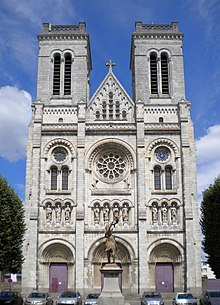Basilica of St. Donatien-et-Saint-Rogatien
| Basilica of St. Donatian and St. Rogatian | |
|---|---|
| Basilique Saint-Donatien-et-Saint-Rogatien | |
 |
|
| Basic information | |
| Location | Nantes, France |
| Geographic coordinates | Coordinates: 47°13′45″N 1°32′33″W / 47.2292588°N 1.5424418°W |
| Affiliation | Roman Catholic |
| Rite | Latin rite |
| Country | France |
| Ecclesiastical or organizational status | minor basilica |
| Status | active, |
| Patron | Donatian and Rogatian |
| Architectural description | |
| Groundbreaking | 1872 |
| Completed | 1889 |
Basilica of St. Donatian and St. Rogatian (French: Basilique Saint-Donatien-et-Saint-Rogatien) is a Roman Catholic minor basilica in Nantes, France. The church was built in the late 19th century and is dedicated to saints Donatian and Rogatian. It was elevated to the rank of minor basilica in 1889.
The church building stands on the site of an ancient Gallo-Roman villa. Excavations in 1873 brought to light an ancient pagan cemetery, a pit in the center of the apse containing 27 nails assigned to the coffins of the two martyrs and reveal that four church buildings were successively below the bascillica.
The promulgation of the Edict of Constantine, nine years after the death of the martyrs, sees developing a cult around the bodies of two brothers as martyrs, first dislocated on the rack, whipped and driven out of the city not far from the current basilica, at the No. 63 rue Dufour, where an executioner speared them in the throat and then beheaded them. According to tradition, their bodies are placed, 21 years after their death, in a gray marble sarcophagus, measuring 2.25 meters long and 75 centimeters wide. The relics then attract pilgrims, requiring the creation of a "guard of honor" consists of the monks of St. Martin. The parish was then considered by Nantais as a "holy land" .
The first church was built in the tradition of family ownership of Nantes saints to 490.
The Norman invasions destroyed the first building, but once peace returned, a new church building was built around the year 980. However, according Dubuisson-Aubenay, the primitive sanctuary remnants still exist in the 17th century, including an ancient apse.
March 16, 1739, the foundation stone of the reconstruction is by Jean-Marie de Trevelec, adviser to the Parliament of Brittany and his wife Françoise Charrette.
Transformed into a hospital during the French Revolution, it was sold in 1796. Once the church returned to use for worship in 1802, the missing parts were reconstructed from 1804, giving birth to a larger church of cruciform shape, consecrated by Bishop Duvoisin 28 March 1806.
...
Wikipedia
